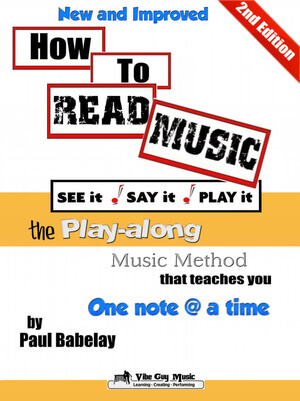Introduction
Learning how to read music should be a natural process of hearing, seeing, saying, recalling, imitating and recognizing the basic vocabulary of music …
Just as you learned to speak and read your own language.
It’s not a Secret
This book isn’t a revolutionary approach with a “secret” technique. Instead,
it is the basics of music presented in a play-along format using a “one note
@ a time” process that helps you figure out
How music works
Music is sound, not sight.
That seems like a no-brainer, but you must understand that reading music is
matching a visual object (music notation) with a sound (music). Too often,
most emphasis is placed on the visual part – and you sound like a robot.
When learning how to read music, you benefit most if you get to
Play along
Music cannot be learned from a book, any more than you can learn to swim
just looking at pictures. You’ve got to dive in. You’ve got to play it.
“How To Read Music: See it, Say it, Play it” uses a real instrument – a
Recorder – to teach you the language of music.
The recorder is the best choice for several reasons:
- It’s inexpensive (around $7.00 for a basic, plastic model)
- It is not physically demanding.
- It is very portable.
- Almost everything you learn transfers to any other instrument.
- Unlike guitars, keyboards, computers and synthesizers – there
aren’t many bells & whistles for distractions.
It may seem as if I am a big fan of the recorder, but the truth is I am NOT trying to teach you to be a great recorder player.
I use the recorder to teach you the Language of music.
Music has basic Elements that are the same for
ALL musicians, ALL genres and ALL instruments.
Learn these elements now, and you’ll have a solid musical foundation to do whatever you want with music.
Now that you know the goal, let’s look at
The Process.
- SEE and recognize a basic rhythm.
- Have the vocabulary to SPEAK it out with the correct labeling.
- PLAY it on your instrument.
Each recorded track has two versions, WITH melody and NO melody.
The version WITH melody includes your solo part.
Eventually, you will not need to play along with the pre-recorded melody.
You will be the soloist.
This insures you learn how to read music accurately and musically.
No guessing – No bad habits…just a helpful guide to keep you on track.
When you’re ready, play along with the NO MELODY version.
Think of it as training wheels on your bike. When you’re ready, take them off.
It is just like
Learning to Read…
This is the letter “a”… it sounds like this… …… Good.
These are the letters “c”…”a”…”t”… sound it out…
“CAT”……Good.
Here is a short sentence. “The – cat – ran.” Very good.
But one day, you don’t have to sound it out anymore.
You see the entire word at once.
Eventually, you see more than one word because you recognize groups of
words… or sentences.
Music works the same way.
The building blocks of music are rhythms.
Rhythm is the most fundamental element of music.
It is your basic vocabulary… your musical ABC’s.
You must develop a working vocabulary of rhythms no matter what style of
music you want to learn or instrument you will play.
It isn’t magic, it’s no more difficult than learning any other language.
Build a basic rhythm vocabulary
Add Pitch – “one note @ a time”
Practice with Play-Along songs
Speak the language.
Methodically, step by step, one note @ a time, you will get Results.


